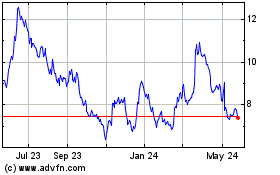SECURITIES AND EXCHANGE COMMISSION
Washington, D.C. 20549
FORM 6-K
REPORT OF FOREIGN PRIVATE ISSUER PURSUANT
TO RULE 13A-16
OR 15D-16 OF THE SECURITIES EXCHANGE ACT OF 1934
For the month of November, 2024
(Commission File No. 1-14862 )
BRASKEM S.A.
(Exact Name as Specified in its Charter)
N/A
(Translation of registrant's name into English)
Rua Eteno, 1561, Polo Petroquimico de Camacari
Camacari, Bahia - CEP 42810-000 Brazil
(Address of principal executive offices)
Indicate by check mark whether the registrant
files or will file annual reports under cover Form 20-F or Form 40-F.
Form 20-F ___X___ Form 40-F ______
Indicate by check mark if the registrant is
submitting the Form 6-K
in paper as permitted by Regulation S-T Rule 101(b)(1). _____
Indicate by check mark if the registrant is
submitting the Form 6-K
in paper as permitted by Regulation S-T Rule 101(b)(7). _____
Indicate by check mark whether the
registrant by furnishing the information contained in this Form is also thereby furnishing the information to the Commission pursuant
to Rule 12g3-2(b) under the Securities Exchange Act of 1934.
Yes ______ No ___X___
If "Yes" is marked, indicate below
the file number assigned to the registrant in connection with Rule 12g3-2(b): 82- _____.

TABLE
OF CONTENTS
| 1. MAIN
HIGHLIGHTS OF 3Q24 |
5 |
| 2. KEY
INDICATORS |
6 |
| 3. MESSAGE
FROM MANAGEMENT |
7 |
| 4. GLOBAL
PETROCHEMICAL INDUSTRY |
8 |
| 5. PERFORMANCE
BY SEGMENT |
10 |
| 5.1 BRAZIL/SOUTH
AMERICA |
10 |
| 5.2 UNITED
STATES AND EUROPE |
16 |
| 5.3 MEXICO |
19 |
| 6. CONSOLIDATED
FINANCIAL RESULT |
24 |
| 6.1 CONSOLIDATED
REVENUE |
24 |
| 6.2 COST
OF GOODS SOLD (COGS) |
25 |
| 6.3 OTHER
REVENUE (EXPENSE), NET |
25 |
| 6.4 RECURRING
EBITDA |
26 |
| 6.5 CONSOLIDATED
FINANCIAL RESULT |
27 |
| 6.6 NET
INCOME (LOSS) |
28 |
| 6.7 INVESTIMENTS |
28 |
| 6.8 CASH
FLOW |
30 |
| 6.9 DEBT
MATURITY PROFILE AND RATING |
30 |
| 7. CAPITAL
MARKETS |
32 |
| 8. LIST
OF APPENDIX |
34 |
FORWARD-LOOKING
STATEMENTS
This
earnings release may contain forward-looking statements. These statements are not historical facts and are based on the Company's management's
current view and estimates of future economic and other circumstances, industry conditions, financial performance and results, including
any potential or projected impact of the geological event in Alagoas and related legal proceedings on the Company's business, financial
condition and results of operations. The words "project", "believe", "estimate", "expect", "plan",
"aim" and other similar expressions, when referring to the Company, are intended to identify forward-looking statements. Statements
regarding the possible outcome of legal and administrative proceedings, implementation of operating and financing strategies and investment
plans, guidance for future operations, the objective of expanding its efforts to achieve the macro sustainable objectives disclosed by
the Company, as well as factors or trends affecting the Company's financial condition, liquidity or results of operations are examples
of forward-looking statements. Such statements reflect the current views of the Company's management and are subject to a number of risks
and uncertainties, many of which are beyond the Company's control. There is no guarantee that the expected events, trends or results
will actually occur. The statements are based on a number of assumptions and factors, including, but not limited to, general economic
and market conditions, industry conditions, operating factors, availability, development and affordability of new technologies. Any change
in such assumptions or factors, including the projected impact of the geological event in Alagoas and related legal proceedings and the
unprecedented impact on the Company's business, employees, contractors, shareholders, investors and other stakeholders, could cause actual
results to differ materially from current expectations. Please refer to the reports filed with the Brazilian Securities and Exchange
Commission (CVM), in particular the factors discussed in the sections for a full discussion of the risks and other factors that may impact
any forward-looking statements contained herein. This Earnings Release is not an offering of securities for sale in Brazil, any securities
may not be offered or sold in Brazil without registration or exemption from registration, any public offering of securities to be made
in Brazil will be prepared through a prospectus that can be obtained from Braskem and which will contain detailed information about Braskem
and management, as well as the financial statements.
BRASKEM
S.A. (B3: BRKM3, BRKM5 and BRKM6; NYSE: BAK; LATIBEX: XBRK), the leading resins producer in the
Americas and the world leader in polymers, announces the calendar for its 3Q24 disclosures,
as follows.
Conference
Call
Portuguese
(original audio) with simultaneous translation into English
November
7, 2024 (Thursday)
Time:
11 a.m. Brasília | 9 a.m. US ET | 2 p.m. London
Link
Zoom: Click here
Investor
Relations Channels
Investor
Relations Website: http://ri.braskem.com.br
IR
mailbox: braskem-ri@braskem.com.br
Telephone:
+55 (11) 3576-9531
Braskem
Invest: podcast for investors,
available on Spotify (in Portuguese) at this link.
Braskem
reports Recurring EBITDA of R$2.4 billion in 3Q24 +44% higher than 2Q24
Highest quarterly Recurring EBITDA since 2Q22
| 1. | MAIN
HIGHLIGHTS OF 3Q24 |


| 3. | MESSAGE
FROM MANAGEMENT |
In
the third quarter of 2024, spreads in the international petrochemical market followed the path of improvement compared to the previous
quarter. The global petrochemical sector remained impacted by higher maritime freight costs, due to the conflicts in the Red Sea, which
affected the trade flow and pricing of petrochemical products in Asia. In addition, scheduled and unscheduled shutdowns in several regions
impacted the level of supply, contributing to the increase in spreads in the international market.
Regarding
Braskem's operating performance, the resumption of operations at the Rio Grande do Sul petrochemical complex had a positive impact on
the utilization rate of the Brazil/South America segment by 2 p.p. compared to the previous quarter. Thus, despite lower demand in the
Brazilian market this quarter, sales in the Brazilian market were higher due to the greater availability of products for sale.
In
the United States & Europe and Mexico segments, utilization rates were lower compared to 2Q24, by 2 p.p. and 4 p.p., respectively,
mainly due to scheduled shutdowns carried out in PP plants in Europe and in a PE plant in Mexico, in addition to the scheduled turnaround
of the international feedstock supplier in Mexico. Due to the lower volume of products available for sale, sales in Mexico were lower
when compared to 2Q24 at 25 thousand tons, while the lower volume in Europe was partially offset by sales in the United States, which
resulted in sale volumes in line with the previous quarter of the United States & Europe segment.
In
this context, consolidated Recurring EBITDA in 3Q24 was US$432 million (R$2.4 billion), representing an increase in relation to 2Q24
(+35%) and 3Q23 (+130%), recording the highest Recurring EBITDA quarterly since the 2nd quarter of 2022. In this scenario,
operational cash generation was R$416 million in 3Q24.
In
September 2024, the Company received around R$ 208 million out of the R$ 293 million related to the investment agreement signed with
Solví and GRI - Gerenciamento de Resíduos Industriais S.A. (“GRI”). This transaction consisted in (i) the sale,
for R$ 293 million, of 498,436 common shares of Cetrel issued by Braskem to GRI; (ii) the subscription by Braskem of 237,150,906 new
common shares issued by GRI for R$ 448 million, through a capital increase, which were paid in by Braskem through the contribution of
771,592 common shares of Cetrel issued by Braskem. The remaining balance will be paid by November 2025. It is worth noting that the strategic
partnership with Solví and GRI, aimed at efficient management of environmental solutions for the industry, reinforces Braskem’s
strategy of creating value in its assets, in addition to resulting in a positive financial impact for the Company.
The
balance of corporate gross debt ended the quarter at US$8.2 billion, 2% lower compared to the previous quarter, with an average term
of approximately 11 years, and with 65% of maturities concentrated from 2030 onwards. Corporate leverage ended the quarter at 5.76x,
a reduction of 1.03x compared to the previous quarter.
Regarding
safety, the overall frequency rate of accidents with and without lost time (CAF + SAF) was 0.91 events per million hours worked in the
year to Sep/24, a reduction of 17% compared to the same period in 2023.
In
conclusion, it is worth reinforcing the continuous challenges that the Brazilian chemical industry has been presenting, with utilization
rates at the lowest level in the last 18 years, according to the Brazilian Chemical Industry Association (ABIQUIM). In this context,
it is important to highlight the approval of the temporary change in the import rate in Brazil for some chemical and petrochemical products
by the Foreign Trade Chamber (CAMEX), including the increase from 12.6% to 20% for imported PE, PP, and PVC. These are resins produced
by the Company, with the expectation of a positive impact on the Brazilian chemical and petrochemical industry.
Management
would once again like to thank Shareholders for the trust placed in Braskem; to Customers, Members, Partners and Suppliers, for their
dedication and competence, which were essential for achieving the Company's results in the quarter.
| 4. | GLOBAL
PETROCHEMICAL INDUSTRY |

International
Market Petrochemical Spreads – 3Q24 vs. 2Q24
BRAZIL/SOUTH
AMERICA
PE
spread was higher (+12%) compared to 2Q24, due to (i) the higher PE price in the US (+4%), caused by the conflicts in the Red Sea
over maritime freight costs in the international market; and (ii) the lower price of naphtha ARA (-2%), mainly as a consequence of the
lower level of demand for its derivatives.
PP
spread was lower (-5%) compared to the previous quarter, due to the lower PP price in Asia (-3%), mainly explained by (i) the higher
supply of resin in the region, due to the new capacity of production.
PVC
spread Par increased (+13%) compared to 2Q24, due to (i) the higher PVC price in Asia (+2%), explained by the limited supply in the
region due to maintenance stoppages in producers in Northeast Asia and increases in international freight due to conflicts in the Red
Sea; (ii) the higher price of soda in the United States (+8%), as a result of the lower level of supply due to the impact of Hurricane
Beryl; and (iii) the lower price of Brent oil (-6%), explained by the global oversupply and the expectation of a smaller recovery in
demand in China.
Spreads
of Main Basic Chemicals were lower (-4%) compared to the previous quarter, mainly due to (i) the lower price of benzene (-7%), as
a consequence of the softer demand for derivatives of this product, mainly styrene; and (ii) the lower price of toluene (-14%), due to
reduced demand in the period explained by softer demand for fuels, in which toluene is used as one of the components of the mixture.
UNITED
STATES AND EUROPE
PP
spread in the US remained in line when compared to 2Q24, while the PP spread in Europe was higher (+3%) due to the increase
in the price of PP in the region (+1%), explained by the lower level of supply due to, (i) maintenance shutdowns by local producers;
and (ii) limited entry of imported PP into the region.
MEXICO
The
PE spread in Mexico was higher (+7%) compared to 2Q24, due to the higher PE price in the US (+3%), as explained above, and the lower
ethane price in the US (-18% ), impacted by (i) softer demand as a result of shutdowns at petrochemical plants in the region; and (ii)
the oversupply of gas, due to limited logistics infrastructure for export, while the construction of logistics terminals is underway.
For
more information on the petrochemical scenario in the quarter, see Appendix 8.1 from this document.
Recurring
EBITDA for the Brazil/South America segment was US$335 million (R$1,858 million) in 3Q24, 45% higher than 2Q24, representing 69% of the
consolidated Recurring EBITDA of the Company's segments in dollars in the quarter. This increase is mainly explained by (i) an increase
of 45 thousand tons, or 6%, in the volume of resin sales in the Brazilian market; (ii) increase of 90 thousand tons, or 14%, in the sales
volume of main chemicals in the Brazilian market; (iii) 8% increase in the average resin spread; and (iv) increase of 37 thousand tons,
or 21%, in the export volume of resins.
Compared
to 3Q23, Recurring EBITDA in 3Q24 increased by 190%, mainly due to (i) an increase of 170 thousand tons, or 31%, in the sales volume
of the main chemicals in the Brazilian market; (ii) a 36% increase in the average spread of resins in the period; (iii) 23% increase
in the spread of main chemicals; and (iv) an increase of 5 thousand tons, or 2%, in the volume of resin exports.

| 5.1.1 | OPERATIONAL
OVERVIEW |
a)
Demand for resins in Brazil (PE, PP, and PVC): lower compared to 2Q24 (-5%), mainly due to (i) lower demand for PE by the beverage
sector and higher inventory levels in the chain; and (ii) lower PVC demand explained by inventory construction in previous quarters.
Compared to 3Q23, the increase (+11%) is mainly explained by (i) higher demand for PE from the packaging sector and inventory build-up
in the chain; and (ii) higher demand for PP, mainly from the household appliances and agriculture sectors.

b)
Average utilization rate of petrochemical crackers: higher compared to 2Q24 (+2 p.p.), mainly explained by the resumption of operations
at the Triunfo Petrochemical Complex, in Rio Grande do Sul, which were interrupted during the month of May due to the extreme weather
event that affected the state.
Compared
to 3Q23, the increase in the utilization rate (+5 p.p.) is mainly explained by the adequacy of production in view of global demand and
the normalization of operations after scheduled and unscheduled shutdowns in 3Q23.

c)
Resin sales volume: in
the Brazilian market, the increase compared to 2Q24 (+6%) is mainly explained by the higher sales volume (i) of PP, mainly due to the
resumption of operations at the Petrochemical Complex of Rio Grande do Sul and the higher demand from the hygiene and cleaning sectors;
and (ii) PVC, due to greater commercial opportunities in the civil construction and sanitation sectors. Compared to 3Q23, sales volume
in the Brazilian market was lower (-2%) mainly due to higher levels of PE and PVC inventories in the transformation chain.

Exports
increased compared to 2Q24 (+21%) mainly due to (i) the higher availability of product for sale; and (ii) the largest commercial opportunities
in South America. The increase compared to 3Q23 (+2%) is mainly explained by the higher volume of PE sales in South America.

d)
Main chemicals sales volume[1]: in the Brazilian market, the increase
compared to 2Q24 (+14%) is mainly explained by the higher sales volume of ethylene, benzene and gasoline, due to the greater availability
of product for sale due to the resumption of operations in Rio Grande do Sul. Compared to 3Q23, the increase (+31%) is mainly explained
by the higher volume of sales (i) of gasoline, by the greater availability of product for sale; and (ii) benzene, paraxylene, propylene,
ethylene and cumene due to higher demand and better commercial opportunities in the Brazilian market.
[1] Main
chemicals refer to: ethylene, propylene, butadiene, cumene, gasoline, benzene, toluene and paraxylene due to the representation of these
products in the segment’s net revenue.

Exports
were lower compared to 2Q24 (-34%) and 3Q23 (-47%), mainly due to the lower sales volume of (i) gasoline and benzene, explained by the
prioritization of serving the local market; and (ii) toluene, due to the lower availability of product for sale.

UPDATES
ABOUT ALAGOAS
The
Company's Management, based on its assessment and that of its external advisors, considering the short-and long-term effects of the elaborated
technical studies, existing information and the best estimate of expenses for implementing the various measures relating to the geological
event in Alagoas, the provision, presents the following movement at the end of the third quarter of 2024:

The
amounts included in the accounting provision relating to the geological event in Alagoas, until September 30, 2024, can be segregated
between the following areas of action and their respective net balances of accounting provision: (a) support in the relocation and compensation
of residents, R$1.2 billion; (b) actions to close, monitor salt cavities, environmental actions and other technical topics, R$1.5 billion;
(c) socio-urban measures, R$1.3 billion; and (d) additional measures, R$834 million.
By
the end of September 2024, the main advances on the fronts of action in Maceió were:
| (i) | 99.8%
of the residents of the properties had already been relocated, and 100% of the criticality
area 00, of the Civil Defense map version 4 of 2020, has already been relocated; |
| (ii) | in
the Financial Compensation and Relocation Support Program (PCF), more than R$4.1 billion
were disbursed from the beginning of the program to the end of September 2024, with about
18,756 proposals paid (97.8% of the total planned); |
| (iii) | 11
salt cavities filled, 9 pressurized, 8 with the filling or pressurization process in progress,
and 7 cavities in preparation for the start of activities; and |
| (iv) | in
the Socio-Urban Action Plan, 8 actions are validated with the signatory authorities in the
Socio-Urban Action Plan (PAS). |
See
Appendix 8.3 in this document for more information on advances made on the action fronts related to the geological event in Alagoas during
the quarter.

A)
Net Revenue: increase in dollars, compared to 2Q24 (+7%), mainly explained by (i) increase of 45 thousand tons, or 6%, in the volume
of resin sales in the Brazilian market; (ii) increase of 90 thousand tons, or 14%, in the sales volume of main chemicals in the Brazilian
market; (iii) increase of 37 thousand tons, or 21%, in the export volume of resins; (iv) 4% increase in the international PE reference;
and (v) 2% increase in the international PVC reference. In reais, the increase (+13%) is also explained by the depreciation of the average
real against the average dollar for the period, of 6.3%.
Compared
to 3Q23, the increase in dollars (+14%) is mainly explained by (i) an increase of 170 thousand tons, or 31% in the sales volume of main
chemicals in the Brazilian market; (ii) 14% increase in the average price of international resins references; (iii) 10% increase in the
average price of international references for main chemicals; and (iv) increase of 5 thousand tons, or 2%, in the volume of resin exports.
In reais, the increase (+30%) is also explained by the depreciation of the average real against the average dollar for the period, of
13.6%.

B)
Cost of Goods Sold (COGS): increase in dollars (+3%), mainly due to (i) increased sales volume of main chemicals in the Brazilian
market; and (ii) increase in resin sales volume in the Brazilian market and exports. In reais, the increase (+9%) is also explained by
the depreciation of the average real against the average dollar for the period, of 6.3%.
In
comparison with 3Q23, the increase in dollars (+4%) is mainly explained by (i) increased sales volume of main chemicals in the Brazilian
market; (ii) increase in the volume of resin exports; and (iii) increase in the price of international naphtha and propane references
by 3% and 8%, respectively. In reais, the increase (+18%) is also explained by the depreciation of the average real against the average
dollar for the period, of 13.6%.
In
3Q24, COGS was positively impacted by PIS/COFINS credits on the purchase of feedstock (REIQ) in US$14 million (R$76 million) and by Reintegra
credits in US$0.4 million (R$2.3 million).

C)
SG&A Expenses: increase in dollars (+10%) compared to 2Q24, mainly due to higher expenses with (i) third-party services; and
(ii) logistics and sales, due to the higher sales volume in the quarter. Compared to 3Q23, lower (-19%) mainly as a result of lower expenses
with consultancy, logistics and storage, explained by the implementation of initiatives to reduce fixed costs carried out in the period.
D)
Recurring EBITDA: represented 69% of the consolidated Recurring EBITDA of the Company's segments in U.S. dollars in the quarter.
| 5.1.3.1 | OPERATIONAL
OVERVIEW |
a)
Utilization rate Green Ethylene: increase compared to 2Q24 (+60 p.p.), explained by the resumption of operations after a scheduled
shutdown due to the extreme weather event that hit the state of Rio Grande do Sul during 2Q24. Compared to 3Q23, the decrease (-13 p.p.)
is mainly explained by the process of reestablishing ethanol supply after the logistical impacts caused by the extreme weather event
during 2Q24.

b)
Sales volume of Green PE (I’m greenTM biobased): the increase (+6%) compared to 2Q24 is mainly explained by the
greater availability of product for sale due to the higher utilization rate, which was partially offset by the rebuilding of inventories
in the period. Compared to 3Q23, the increase (+10%) is mainly explained by commercial efforts for market development after the completion
of the project to increase Green Ethylene production capacity in 2023.

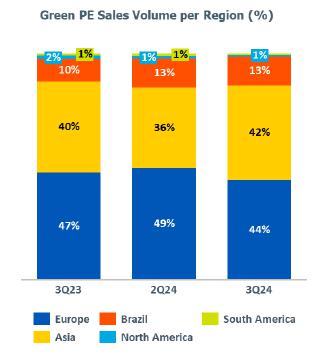
| 5.1.3.2 | FINANCIAL
OVERVIEW |
A)
Green PE and ETBE[2] net revenue: increase compared to 2Q24 (+5%),
mainly explained by the increase of around 3 thousand tons, or 6%, in the volume of sales of Green PE, due to the normalization of operations
at the Triunfo Petrochemical Complex, in Rio Grande do Sul. Compared to 3Q23, the reduction is mainly explained by the reduction in the
price of ETBE and Green PE in the period.
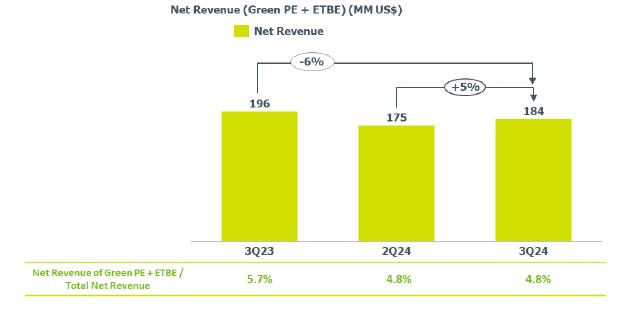
| 5.2 | UNITED
STATES & EUROPE |
Recurring
EBITDA was US$71 million (R$395 million), 53% higher than 2Q24 and 18% higher than 3Q23, representing 15% of the consolidated Recurrent
EBITDA of the Company's segments in dollars in the quarter.
The
increase compared to 2Q24 is mainly explained by the optimization of the sales mix and the flexibility in purchasing propylene in the
United States. In relation to 3Q23, the increase is explained by the 3% increase in the average PP spread in the international market
and the flexibility in purchasing propylene in the United States. This effect was partially offset by the lower sales volume in the period
(-8%).
[2] Product
that uses renewable feedstock, ethanol in its composition

| 5.2.1 | OPERATIONAL
OVERVIEW |
a)
PP demand: PP demand in North America was lower (-2%) compared to 2Q24, mainly due to higher inventories levels in the chain. Compared
to 3Q23, demand in North America was higher (+3%), mainly due to the improvement in the economic scenario in the region, compared to
the same period of the previous year.
In
Europe, PP demand was lower compared to 2Q24 (-8%) mainly due to the seasonality of the period. In relation to 3Q23, demand was higher
(+1%), mainly explained by the anticipation of purchases by the chain given the uncertainty of the geopolitical scenario.

b)
Average utilization rate of PP plants: lower than in 2Q24 (-2 p.p.) and 3Q23 (-5 p.p.), mainly due to scheduled maintenance shutdowns
at the plants in Europe.

c)
PP sales volume: in line with 2Q24. Compared to 3Q23, the reduction (-8%) is mainly explained by the lower availability of product
for sale.
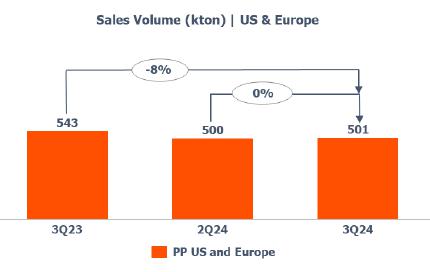
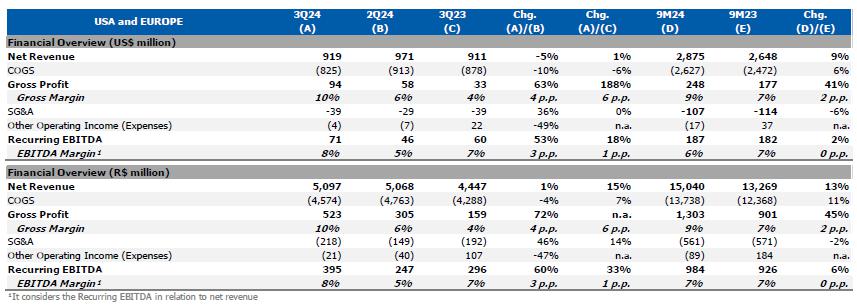
A)
Net Revenue: lower in dollars (-5%) compared to 2Q24, mainly explained by the lower volume of feedstock resale operations in Europe.
Excluding this effect, revenue was higher in dollars (+9%), due to the increase in the average price of international PP references.
Compared
to 3Q23, net revenue remained in line, explained by the lower volume of feedstock resale in Europe which was partially offset by the
increase in the international reference for PP in United States (+30%) and Europe (+11%) in the period.
B)
Cost of Goods Sold (COGS): lower in dollars compared to 2Q24 (-10%) and 3Q23 (-6%) due to lower feedstock resale operations in Europe.
Excluding this effect, COGS was higher in dollar in relation to 2Q24 (+9%) and 3Q23 (+20%), mainly due the increase in the average price
of the international references of propylene in United States of 12% and 47%, respectively. This effect was partially offset by the optimization
and flexibility in the purchase of propylene in the United States.
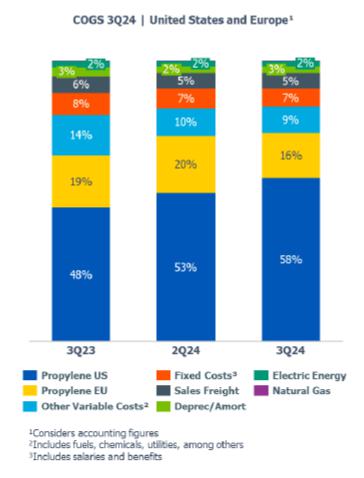
C)
SG&A Expenses: in dollars, the increase compared to 2Q24 (+36%) is explained by higher expenses with (i) logistics and storage
services; and (ii) third parties services. In relation to 3Q23, it remained in line.
D)
Recurring EBITDA: represented 15% of the consolidated Recurring EBITDA of the Company's segments in U.S. dollars in the quarter.
Recurring
EBITDA in the Mexico segment was US$80 million (R$445 million), higher than in 2Q24 (+44%), representing 16% of the consolidated Recurring
EBITDA of the Company’s segments. The increase is mainly explained by the 6% increase in the PE spread in the international market.
Compared
to 3Q23, Recurring EBITDA was higher in US dollars (+US$73 million), mainly explained by the 47% increase in the PE spread in the international
market.

a)
PE demand in the Mexican market: increased compared to 2Q24 (+11%) and 3Q23 (+6%), mainly due to the formation of inventory in the
transformation chain.
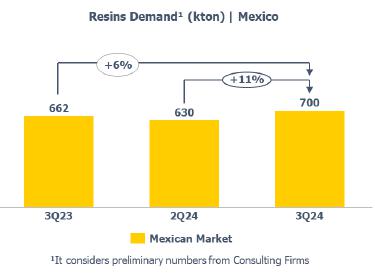
b)
Average utilization rate of PE plants: lower compared
to 2Q24 (-4 p.p.) mainly due to (i) the lower volume of ethane imported through the Fast Track solution, of 19 thousand barrels per day,
compared to 23 thousand barrels in 2Q24, due to the scheduled shutdown of the international supplier; and (ii) the scheduled maintenance
shutdown at one of the PE plants for 35 days during the quarter.
Compared
to 3Q23, the increase (+8 p.p.) is mainly explained by the normalization of operations compared to the same period of the previous year,
due to failures in the national electricity system caused by storms in the region in 3Q23.
The
volume of ethane supplied by PEMEX in the quarter was around 29 thousand barrels per day, compared to 26 thousand barrels in 2Q24 and
3Q23.
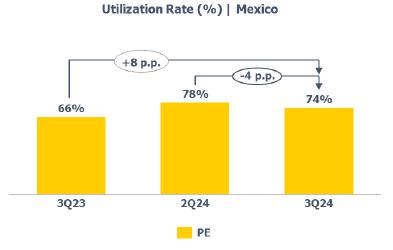
c)
PE sales volume: lower compared to 2Q24 (-11%) explained by the lower availability of product for sale, which was partially offset
by inventories optimization in the period. Compared to 3Q23 (-3%), the reduction is explained by the greater supply from PE producers
in North America.
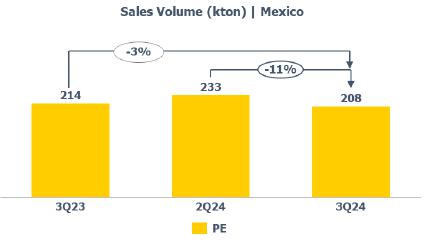
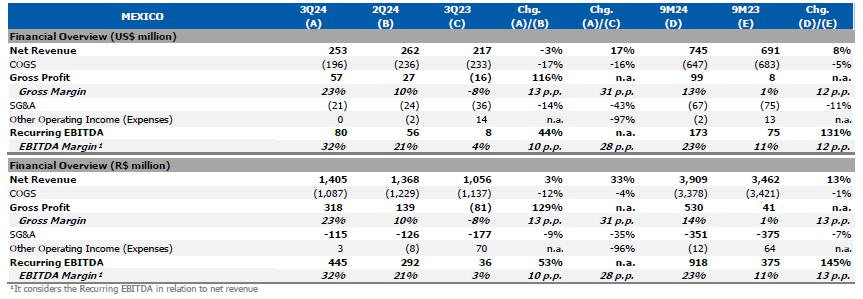
A)
Net Revenue: lower in US dollar terms (-3%) compared to 2Q24, mainly due to the reduction of 25 thousand tons, or 11%, in the volume
of PE sales, partially offset by the 3% increase in the PE reference in the international market. In reais, the increase (+3%) is explained
by the depreciation of the average real against the average dollar in the period, of 6.3%.
The
increase compared to 3Q23 (+17%) is mainly explained by the 24% increase in the price of the international reference for PE in the quarter.
In reais, the increase (+33%) is explained by the depreciation of the average real against the average dollar for the period, of 13.6%.
Resin
Sales by Region (% in tons)
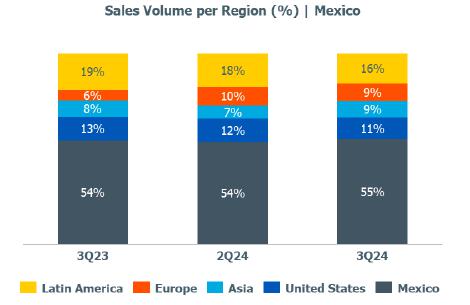
B)
Cost of Goods Sold (COGS): the reduction in dollars (-17%) and reais (-12%) compared to 2Q24 is mainly explained by (i) the reduction
in the price of ethane in the international market in the quarter (-18%); and (ii) a reduction of 25 thousand tons, or 11%, in the volume
of PE sales.
Compared
to 3Q23, the reduction in dollars (-16%) and reais (-4%) is mainly explained by (i) the reduction in the price of ethane in the international
market in the quarter (-47%); and (ii) a reduction of 6 thousand tons, or 3%, in the volume of PE sales.
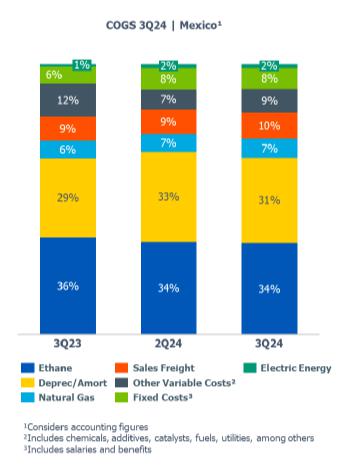
C)
SG&A Expenses: decrease in dollars compared to 2Q24 (-14%) and 3Q23 (-43%), mainly due to lower logistics and storage expenses.
D)
Recurring EBITDA: represented 16% of the consolidated Recurring EBITDA of the Company's segments in U.S. dollars in the quarter.
The
total investment planned for 2024 by Braskem Idesa is US$252 million (R$1.3 billion), of which US$201 million refers to the construction
of the ethane import terminal, which is financed through the Syndicated Project Finance Loan, contracted by Terminal Química Puerto
México (TQPM).
Operating
Investments in 3Q24: the main operational investments made by Braskem Idesa were in initiatives in asset reliability and integrity
and investments in health, safety and environment, totaling US$11 million (R$62 million) in the quarter.
Strategic
Investments in 3Q24: it refers to the continued construction of the ethane import terminal through Terminal Química Puerto
México (TQPM), which is financed by the Syndicated Project Finance Loan.

| 5.3.3.1 | ETHANE
IMPORT TERMINAL |
In
2021, Braskem Idesa approved and started the construction project for the ethane import terminal in Mexico, with a capacity of up to
80 thousand barrels of ethane per day, which will allow Braskem Idesa to operate up to 100% of its production capacity. In the same year,
a Joint-Venture was formed between Braskem Idesa and Advario, through the subsidiary Terminal Química Puerto México ("TQPM"),
with a 50% stake for each shareholder.
The
total estimated value for the construction of the terminal is US$446 million (CAPEX ex-VAT), of which US$408 million are financed, in
the Syndicated Project Finance Loan, announced by TQPM in November 2023.
The
total amount disbursed at the ethane import terminal from the beginning of the project to the end of 3Q24 was approximately US$345 million,
with net disbursements made by Braskem Idesa totaling approximately US$95 million[3].
In 2024, the cash needs for the construction of the terminal will be disbursed through the financing obtained, without the need for additional
contribution by Braskem Idesa. The amount invested by TQPM in the ethane import terminal in the third quarter of 2024 was US$51 million
(R$281 million), using the financing obtained as sources of funds.
The
construction of the terminal, which began in July 2022, has reached, by September 2024, a physical progress of 87%. Construction of the
project is expected to be completed by the end of 2024, with operations expected to start in the first quarter of 2025.
| 5.3.4DEBT | MATURITY
PROFILE AND RATING |
As
of September 30, 2024, the average debt maturity was around 6.2 years, with 95% maturing from 2029. Braskem Idesa's weighted average
cost of debt was +7.3% p.a.
The
liquidity level of US$229 million guarantees the coverage of debt maturities in the next 28 months.
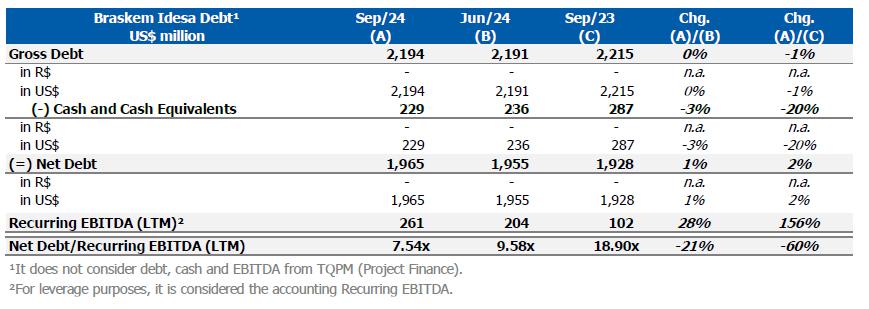
[3]
Includes Value Added Tax (VAT).
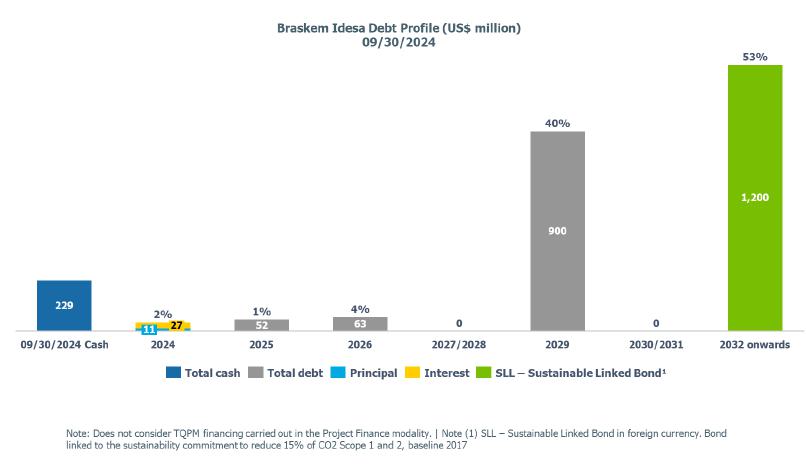
Rating
| CORPORATE
CREDIT RATING – BRASKEM IDESA |
| Agency |
Rating |
Outlook |
Date |
| S&P |
B |
Negative |
07/05/2024 |
| FITCH |
B+ |
Negative |
12/20/2023 |
| 6.CONSOLIDATED | FINANCIAL
OVERVIEW |
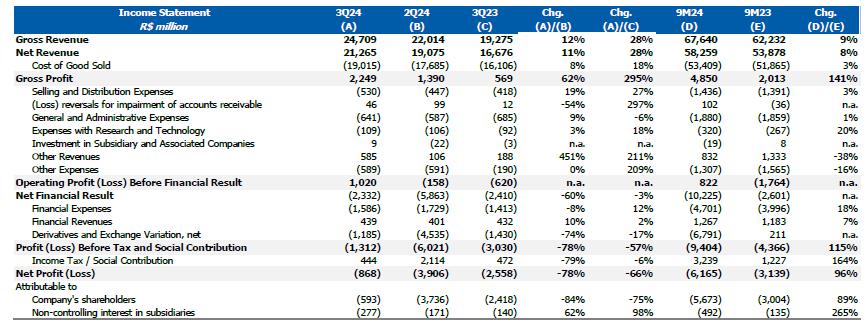
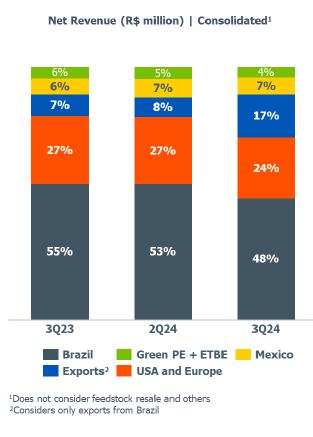
| 6.2 | COST
OF GOODS SOLD (COGS) |
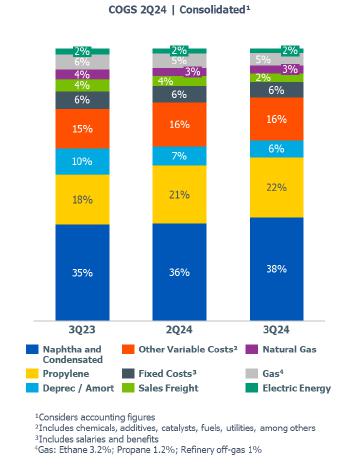
| 6.3 | OTHER
REVENUE (EXPENSE), NET |
At
the end of the quarter, the Company recorded a total net expense of R$4 million, higher than 2Q24, impacted by (i) other income, mainly
formed by the gain from the sale of control of Cetrel; and (ii) other expenses, mainly comprised of expenses relating to the Alagoas
geological event.

Braskem's
Recurrent EBITDA was US$432 million (R$2.4 billion) in 3Q24, 35% higher than 2Q24, mainly due to the (i) increase of 45 thousand tons,
or 6%, in sales volume of resins in the Brazilian market in the Brazil/South America segment; (ii) increase of 90 thousand tons, or 14%,
in the sales volume of main chemicals in the Brazilian market in the Brazil/South America segment; (iii) 8% increase in the average resin
spread in the Brazil/South America segment; (iv) increase of 37 thousand tons, or 21%, in the export volume of resins; (v) 6% increase
in the PE spread in the international market in the Mexico segment; and (vi) optimization of the sales mix and flexibility in the purchase
of feedstocks in the United States.
Compared
to 3Q23, Recurrent EBITDA increased by 130%, mainly due to (i) an increase of 170 thousand tons, or 31% in the sales volume of main chemicals
in the Brazilian market in the Brazil/South America segment; (ii) 36% increase in the average resins spread in the period in the Brazil/South
America segment; (iii) 47% increase in the PE spread in the Mexico segment; (iv) 23% increase in the spread of main chemicals in the
Brazil/South America segment; and (v) increase of 5 thousand tons, or 2%, in the volume of resin exports in the Brazil/South America
segment.
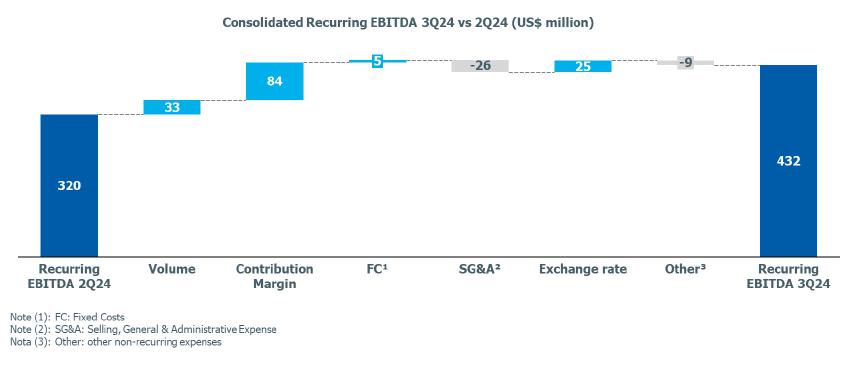
[4]
Braskem's consolidated results are equal to the sum of the results of Brazil, the United States and Europe and
Mexico subtracted from the eliminations and reclassifications of purchases and sales between the Company's reportable segments and added
to Other Segments.
| 6.5 | CONSOLIDATED
FINANCIAL RESULT |
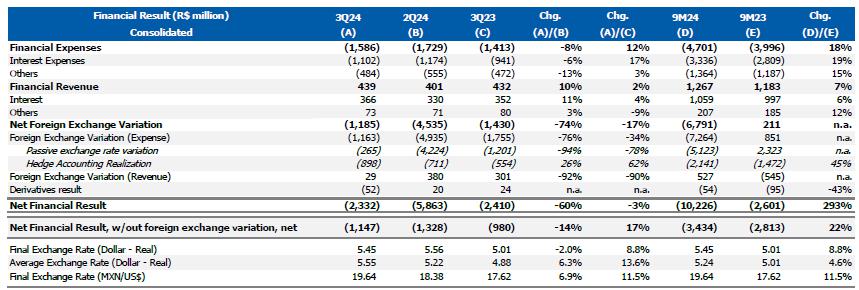
Financial
expenses: lower compared to 2Q24 (-8%), mainly explained by lower expenses with (i) interest due to the lower consolidated gross
debt balance in the period; and (ii) reversal of interest on tax liabilities due to the update of the prognosis of classified as probable
to closed/success.
Compared
to 3Q23, the increase (+12%) is explained by higher interest expenses due to (i) the increase in the balance and cost of gross debt between
the periods in the amount of R$4.3 billion; and (ii) the depreciation of the average real against the average dollar for the period of
13.6%.
Financial
income: increase compared to 2Q24 (+10%) and 3Q23 (+2%), explained by the increase in interest on tax credits, partially offset
by lower interest income from financial investments due to the reduction in the cash position in the period.
Net
exchange variation: the net negative exchange in 3Q24 is mainly explained by (i) the impact of hedge accounting; and (ii) the
depreciation of the Mexican peso at the end of the period against the dollar on Braskem Idesa's average net exposure to the dollar in
the amount of US$2.3 billion. This result was partially offset by the appreciation of the real at the end of the period against the dollar
on Braskem's average net exposure to the dollar in the amount of US$3.9 billion.
Transactions
in financial instruments under hedge accounting
Regarding
Braskem S.A.'s export hedge accounting, the Company carried out US$200 million (R$728.3 million) in exports in the quarter from a discontinued
flow in 2021. The initial designation fee was R$/US$2.0017, defined in March 2013, while the completion fee was R$/US$5.6430, defined
in October 2021. The balance of financial instruments designated for this hedge accounting at the end of 3Q24 was US$5.15 billion.
As
for Braskem Idesa's export hedge accounting, the Company carried out US$90.3 million (MXN 585.1 million) in discontinued flows exports
in the quarter between 2016 and 2021. The average initial assignment fee was MXN/US$13.6509, and the average achievement fee was MXN/US$20.1286.
The balance of instruments designated for this hedge accounting at the end of 3Q24 was US$2.2 billion.
Long-term
Currency Hedge Program
Braskem's
inputs and products have prices denominated or strongly influenced by international commodity prices, which are usually denominated in
U.S. dollars. As of 2016, Braskem contracted derivative financial instruments to mitigate part of its cash flow exposure denominated
in reais. The program's main form of mitigation is dollar call and put option contracts, protecting flows expected for a horizon of up
to 18 months.
As
of September 30, 2024, Braskem had a total outstanding value of operations (notional) purchased in puts of US$1.4 billion, at an average
exercise price of R$/US$4.60. Concomitantly, the Company also had a total open value of operations (notional) sold in calls of US$0.97
billion, at an average exercise price of R$/US$6.61. The contracted operations have a maximum maturity of 18 months. The fair value marking
of these Zero Cost Collar ("ZCC") operations was negative at R$32.4 million at the end of the quarter.
As
a result of the high volatility of the dollar in the period, there was an exercise of options. There was a negative cash effect of R$1.3
million in 3Q24.

In
the quarter, the Company recorded a net loss of US$106 million, or R$593 million, mainly due to the impact of R$1.2 billion of negative
exchange rate variation on the financial result. Year-to-date, the Company recorded a net loss attributable to shareholders of US$1.1
billion, or R$5.7 billion.
Braskem
expected investment for 2024 (ex-Braskem Idesa) is US$440 million (R$2.2 billion). At the end of 3Q24, Braskem made investments in the
amount of approximately US$81 million (R$448 million).
Operating
Investments 3Q24: the main operational investments made include (i) the scheduled maintenance shutdown at a PVC plant in Brazil;
(ii) investments to improve the mechanical integrity of assets in Brazil; and (iii) investments related to increasing the reliability
and operational safety of industrial assets.
Strategic
Investments 3Q24: the funds were mainly directed to (i) the completion of payments for the project to increase the capacity of
the green ethylene plant in Brazil; (ii) projects associated with the energy efficiency of industrial assets; and (iii) initiatives in
innovation and technology.
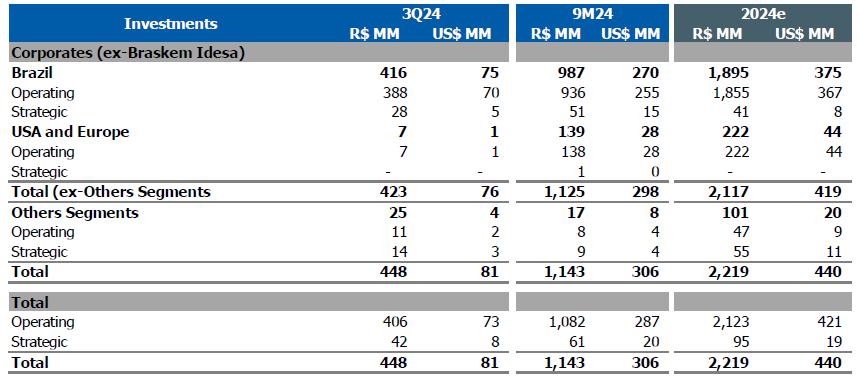
In
3Q24, the main investments related to the Macro-Goals for Sustainable Development were (i) projects associated with the reduction of
CO2e emissions and the energy efficiency of industrial assets; and (ii) projects related to industrial safety.

| 6.7.1 | GLOBAL
GROWTH STRATEGY |
Driven
by its Corporate Growth Strategy in the quarter, Braskem remained focused on advancing projects related to its growth avenues, highlighting
the following:
| a. | Launch
of Braskem's first leased ethane vessel |
On
September 29th, in China, the first vessel under leasing from Braskem was launched. The Brilliant Future vessel, is in the final phase
of construction and will be delivered for operation in January 2025. Dedicated logistics, lasting 15 years, will be used to transport
ethane from the United States for Mexico, ensuring stability for operations at Braskem Idesa.
| b. | Ethane
Import Terminal Construction in Mexico |
By
September 2024, the physical progress of the terminal's construction reached 87%, an increase of 11.5% compared to 2Q24. The expectation
of completion remained for the end of 2024, with operations starting during the first quarter of 2025.
More
details about the project are available in section 5.3.3.1.
| a. | New
Renewable Innovation Center in the United States |
Opened
on September 11, 2024, through an investment of approximately US$20 million, Braskem's New Renewable Innovation center is focused on
accelerating early-stage research into renewable chemicals and materials, expanding the Company's capacity in the areas of biotechnology,
catalysis and process engineering. Strategically located in Lexington, Massachusetts, the innovation center is part of Boston's biotechnology
and innovation ecosystem, in close to more than 60 universities.
| b. | Braskem
Siam – contract for FEED |
Braskem
Siam signed the FEED[5] Agreement with Toyo Engineering Corporation
on September 18, 2024. Toyo Engineering will develop the extended basic engineering and CAPEX estimate for the 200kt Green Ethylene plant
in Thailand and is expected to be completed in the second quarter of 2025.
| a. | BloombergNEF
Circular Economy Ranking 2024 |
[5]Front
End Engineering Design
In
October, Braskem was recognized for its performance in sustainability and circularity, being ranked second in BloombergNEF's 2024 Circular
Economy Company Ranking. This ranking evaluated the circular economy objectives of 40 companies, including 20 brandowners and 20 plastic
producers.
The
Company presented an operational cash generation of R$416 million in 3Q24. This result is mainly explained by the higher Recurrent EBITDA
in the quarter, which was offset by the negative variation in working capital. During 3Q24, the negative variation in working capital
is mainly explained:
(i) the
higher stock of feedstock in the period, explained by the early unloading of a ship of imported naphtha on the last day of the quarter;
and
(ii) by
reducing the number of days of accounts payable to suppliers due to the lower price of naphtha on the international market.
The
recurring cash generation in 3Q24 resulted in a consumption of R$1.1 billion. The variation in relation to 2Q24 is explained by (i) the
lower operational cash generation, mentioned above; and (ii) the higher payment of interest due to the semi-annual payments of debt securities
issued on the international market by the Company. Additionally, in 3Q24, Braskem concluded the sale of control of Cetrel S.A., for a
total of R$293.5 million, of which R$208.5 was received in the quarter.
Considering
the disbursements related to the geological event in Alagoas, Braskem presented a cash consumption of R$ 1.9 billion in 3Q24.
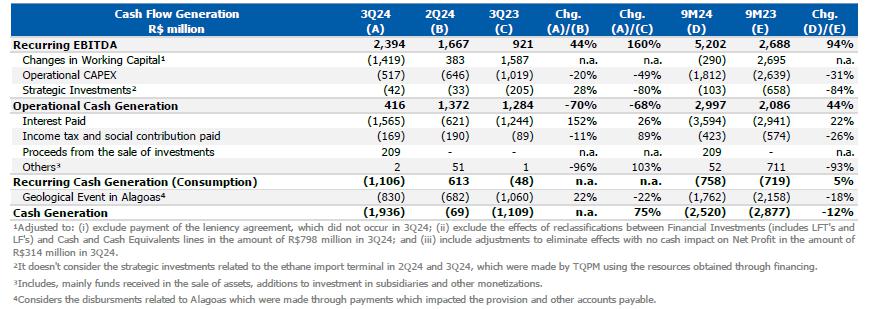
| 6.9 | DEBT
MATURITY PROFILE AND RATING |
As
of September 30, 2024, the balance of corporate gross debt was US$8.2 billion, with 95% of maturities concentrated in the long term and
5% in the short term. Regarding net debt, the balance at the end of September 2024 was US$5.6 billion. Corporate debt in foreign currency
represented, at the end of the period, 91% of the Company's total debt.
As
of September 30, 2024, the average term of corporate debt was around 11 years, with 65% of debts concentrated from 2030 onwards. The
weighted average cost of the Company's corporate debt was exchange rate variation +6.14% p.a.
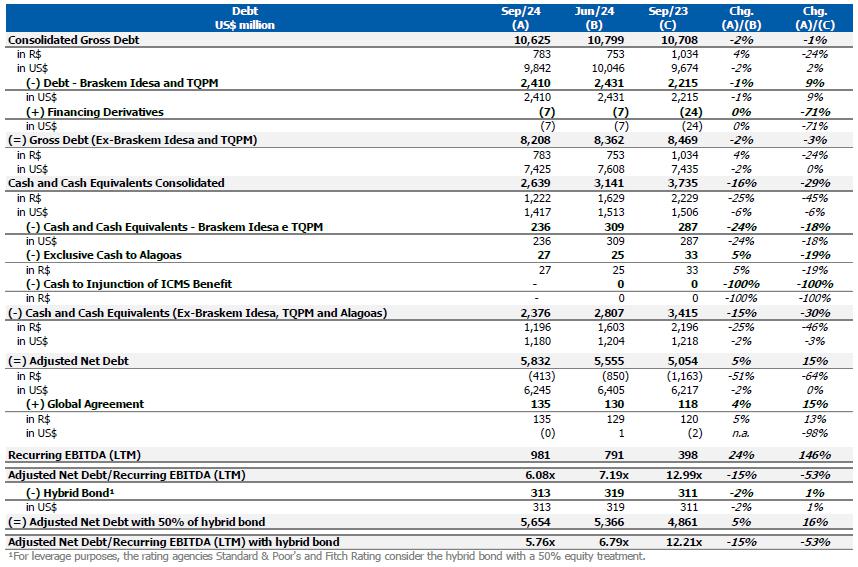
The
liquidity level of US$2.4 billion, in September 2024, guarantees the coverage of debt maturities in the next 52 months and does not consider
the international revolving credit line available in the amount of US$1.0 billion, maturing in 2026.
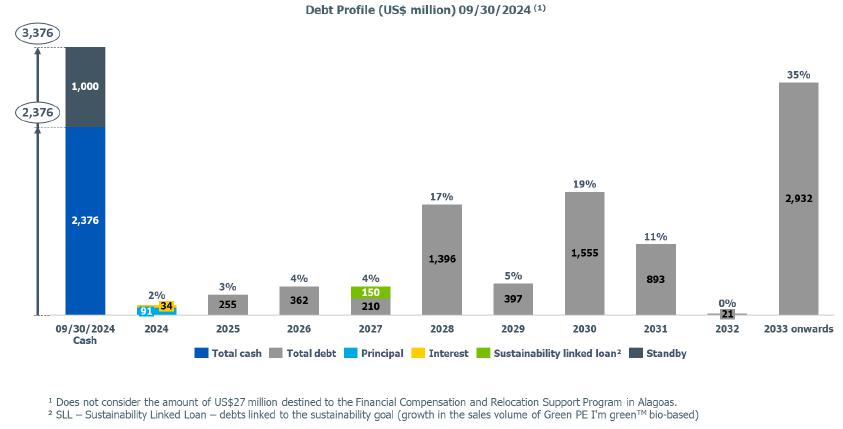
Additionally,
the Company issued a bond in October that received around US$4.5 billion in orders, allowing it to issue US$850 million at a cost of
8.00% p.a. The operation was carried out to repurchase the Hybrid Bond maturing in 2081 and to enhance liquidity, including debt maturities
in 2024/2025, and contribute to maintaining the Company's liquidity. This operation is not yet reflected in the debt profile above.
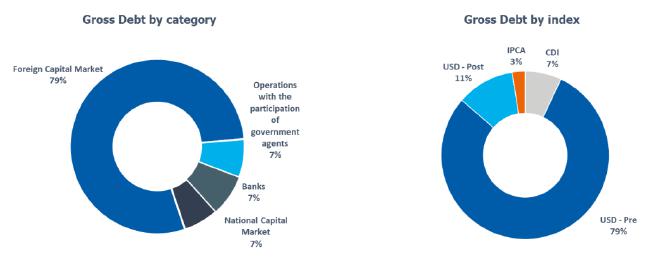
Rating
| CORPORATE
CREDIT RATING – GLOBAL SCALE |
| Agency |
Rating |
Outlook |
Date |
| FITCH |
BB+
|
Negative
|
10/07/2024 |
| S&P |
BB+
|
Negative
|
10/07/2024 |
| |
|
|
|
| CORPORATE
CREDIT RATING – NATIONAL SCALE |
| Agency |
Rating |
Outlook |
Date |
| FITCH |
AAA(bra) |
Stable |
10/07/2024 |
| S&P |
brAAA |
Negative |
10/07/2024 |
As
of September 30, 2024, Braskem's shares were quoted at R$19.93/share (BRKM5) and US$7.34/share (BAK). The Company's shares
are part of Level 1 of corporate governance of B3 – Brasil, Bolsa e Balcão and are traded on the New York Stock Exchange
(NYSE), through Level 2 ADRs (American Depositary Receipts), and each Braskem ADR (BAK) corresponds to two class "A" preferred
shares issued by the Company, and on the Latibex Stock Exchange, in Madrid, under the ticker XBRK.
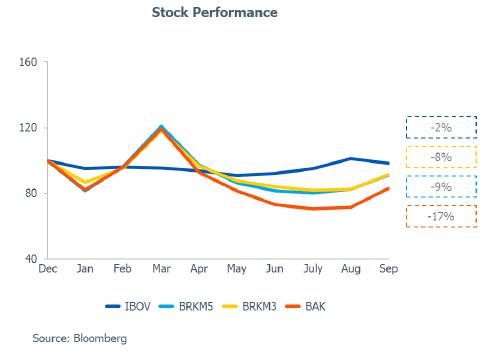

7.2 PERFORMANCE
OF CORPORATE DEBT SECURITIES
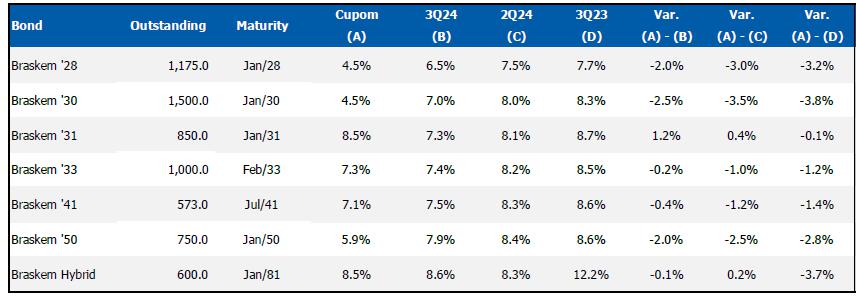
BRAZIL/SOUTH
AMERICA
| · | PE
Spread[6]: increase
compared to 2T24 (+12%). |
| o | The
price of PE in the US was higher (+4%) compared to 2Q24, mainly due to the developments of
the conflicts in the Red Sea, resulting in (i) an increase in maritime freight levels, impacting
prices in Asia; and (ii) higher export volume from the United States with better prices,
an international reference used to define prices in Brazil. |
| o | The
price of naphtha ARA decreased (-2%) compared to 2Q24, mainly explained by the lower demand
for its derivatives. |
| o | Compared
to 3Q23, the spread was higher (+61%) mainly due to (i) the higher PE price (+23%) in the
period, as a consequence of the developments of the conflicts mentioned above. |
| · | PP
Spread[7]: lower
reduction compared to 2Q24 (-5%). |
| o | The
PP price in Asia was lower (-3%) compared to 2Q24, mainly due to (i) the higher supply of
resin in the region, as a result of the lower number of maintenance shutdowns by local producers;
and (ii) the lower demand in the period. |
| o | The
price of ARA naphtha was lower (-2%) compared to 2Q24, as previously explained. |
| o | Compared
to the same quarter of 2023, the spread was higher (+9%) due to the higher PP price in Asia
(+5%), as a consequence of the increase in international sea freight, impacted by the logistical
restrictions caused by the conflicts in the Red Sea. |
| · | PVC
Par Spread[8]:
increase compared to
2Q24 (+13%). |
| o | The
price of PVC in Asia increased (+2%) compared to 2Q24, mainly impacted by (i) limited supply
due to maintenance shutdowns in producers in the region and lower import levels; and (ii)
by the increase in international freight, due to the unfolding of the conflicts in the Red
Sea, reflecting an increase in the export price between Asian countries. |
| o | Compared
to 3Q23, the PVC Par spread was lower (-4%), impacted by (i) lower PVC prices in Asia (-1%),
due to lower demand in the period; and (ii) increase in the price of ethylene Europe (+8%),
due to limited supply by producers due to shutdowns at refineries in the region. |
| · | Spread
on Main Basic Chemicals[9]:
decrease compared
to 2Q24 (-4%). |
| o | The
price of the main chemicals was lower (-3%) compared to the previous quarter, mainly impacted
by (i) the reduction in the price of benzene (-7%), as a consequence of the lower demand
for derivatives, mainly styrene; and (ii) reduction in the price of toluene (-14%), due to
lower demand in the period. |
| o | Compared
to 3Q23, the spread of Key Basic Chemicals was higher (+23%), mainly impacted by (i) the
increase in the price of butadiene (+110%) due to supply constraints due to shutdowns due
to Hurricane Beryl, which occurred in July and maintenance shutdowns that occurred in August;
(ii) higher propylene price (+47%), due to operational problems in refineries in the United States, limiting supply; and (iii) higher price of benzene (+21%), influenced by the lower entry of imported
products into the United States. |
[6]
(US PE Price – naphtha ARA price)*82%+(US PE Price – 50% US ethane price – 50% US propane
price)*18%.
[7]
Asia PP price – Naphtha ARA price.
[8]
The PVC Par spread better reflects the profitability of the Vinyl business, which is more profitable
compared to the temporary/nonintegrated business model of 2019/20, under which the Company imported EDC and caustic soda to keep serving
its customers. Its calculation formula is: Asia PVC Price + (0.685*US Caustic Soda) - (0.48*Europe Ethylene) - (1.014*Brent).
[9]
Average price of base chemicals (Ethylene (20%), Butadiene (10%), Propylene (10%), Cumene (5%),
Benzene (20%), Paraxylene (5%), Gasoline (25%) and Toluene (5%), based on Braskem’s sales volume mix) – naphtha ARA price.
UNITED
STATES AND EUROPE
| · | US
PP Spread[10]:
remained in line with
2Q24. |
| o | Compared
to the same quarter of the previous year, the spread remained in line. |
| · | Europe
PP Spread[11]:
increase (+3%) compared
to 2Q24. |
| o | The
PP price compared to 2Q24 was higher (+1%) due to (i) lower supply, impacted by stoppages
at producers in the region, and (ii) the lower volume of imported resins, as a consequence
of the increase in freight and logistical restrictions caused by the conflicts in the Red
Sea. |
| o | The
price of propylene in Europe remained in line compared to 2Q24. |
| o | Compared
to 3Q23, the spread was higher (+15%), mainly impacted by the higher PP price in Europe (+11%)
in 3Q24, explained by the greater restriction on the entry of imports and stoppages at producers
in the region, as previously commented. |
MEXICO
| · | North
America PE Spread[12]:
increase compared
to 2Q24 (+7%). |
| o | The
PE price in the US was higher (+3%) compared to 2Q24, as previously explained. |
| o | Regarding
feedstock, the price of ethane was lower (-18%) compared to 2Q24 due to (i) lower demand
in the United States as a result of shutdowns at petrochemical plants in the region, which
impacted about 10% of nominal capacity in the quarter; and (ii) the oversupply of gas, due
to the logistics for export still being under construction. |
| o | Compared
to the same period of the previous year, the spread was higher (+47%), mainly impacted by
(i) the lower price of ethane (-47%) in the US, influenced by the factors mentioned above;
and (ii) the higher EP price in the region (+24%), due to the impacts caused by the conflicts
in the Red Sea and the increase in international freight. |
[10]
U.S. PP – U.S. propylene price
[11]
U.S. PE – U.S. ethane price
[12] U.S. PE Price – U.S. ethane
Resin
sales by sector (%) | Brazil/South America segment
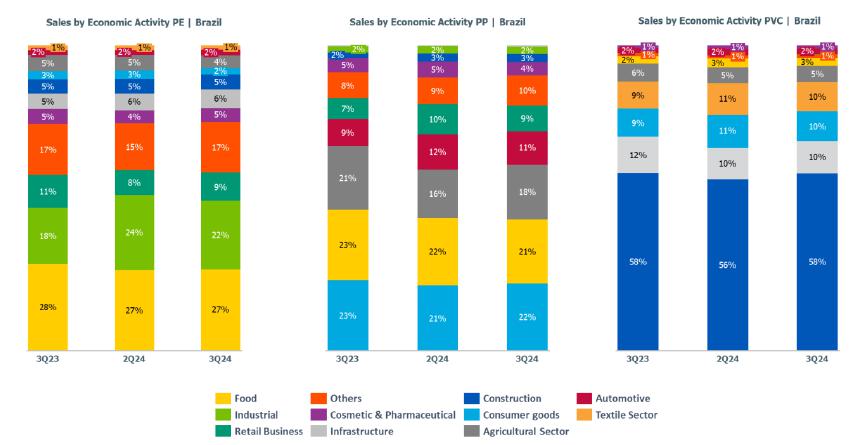
Resin
sales by sector (%) | Mexico segment
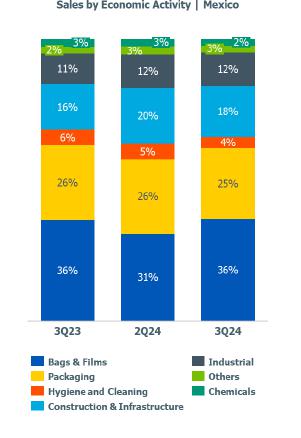
The
Company operated, since its formation and subsequently as the successor of the company Salgema, salt mining wells located in Maceió
city, Alagoas state, with the purpose of supplying raw material to its chlor-alkali and dichloroethane plant. In March 2018, an earthquake
hit certain districts of Maceió, where the wells are located, and cracks were found in buildings and public streets of Pinheiro,
Bebedouro, Mutange, and Bom Parto districts.
In
May 2019, the Geological Survey of Brazil (“CPRM”) issued a report indicating that the geological phenomenon observed in
the region could be related to the rock salt exploration activities developed by Braskem. On May 9, 2019, the salt mining operation was
fully ended by the Company.
Since
then, the Company has been devoting its best efforts to understand the geological event: (i) possible surface effects; and (ii) the analyses
of stability of salt cavities. The results are being shared with the Brazilian National Mining Agency (“ANM”) and other pertinent
authorities, which the Company has been maintaining constant dialogue.
Braskem
presented to ANM the measures for shutting down its salt mining fronts in Maceió, with measures for the closure of its cavities,
and, on November 14, 2019, it proposed the creation of a protective area surrounding certain cavities as a precautionary measure to ensure
public safety. These measures are based on a study conducted by the Institute of Geomechanics of Leipzig (IFG), in Germany, an international
reference in the geomechanical analysis of areas of salt extraction by dissolution and are being adopted in coordination with the Civil
Defense of Maceió and other authorities.
As
a result of the geological phenomenon, negotiations were conducted with public and regulatory authorities that resulted in the Agreements
executed, including:
i) Agreement
to Support the Relocation of People in Risk Areas (“Agreement for Compensation of Residents"), entered into with State Prosecution
Office (“MPE”), the State Public Defender’s Office (“DPE”), the Federal Prosecution Office (“MPF”)
and the Federal Public Defender’s Office (“DPU”), which was ratified by the court on January 3, 2020, adjusted by its
resolutions and subsequent amendments, , which establish cooperative actions for relocating residents from risk areas, defined in the
Map of Sectors of Damages and Priority Action Lines by the Civil Defense of Maceió (“Civil Defense Map”), as updated
in December 2020 (version 4), and guaranteed their safety, which provides support, under the Financial Compensation and Support for Relocation
Program (“PCF”) implemented by Braskem to the population in the areas of the Civil Defense Map, as well as the dismissal
of the Public-Interest Civil Action (Reparations for Residents), as detailed in Note 23.1 (i) of the consolidated and individual Financial
Statements of September 30, 2024;
ii) Agreement
with the Labor Prosecution Office in Alagoas (MPT-AL) on February 14, 2020, in the amount of R$40 for implementation of the Program for
Recovery of Business and Promotion of Educational Activities for residents and workers in the districts affected by the geological phenomenon.
The program consists of support for the construction of daycare centers and schools and for administering professional training programs,
as well as support for the Civil Defense to hire skilled professionals to continue monitoring the risk areas in the districts affected.
On March 3, 2020, with the ratification of the agreement by the courts, the Public-Interest Civil Action (Reparation for Workers) was
extinguished;
iii)
Agreement to Dismiss the Public-Interest Civil Action on Socio-Environmental Reparation (“ACP
Socio-Environmental Reparation”) and the Agreement to define the measures to be adopted regarding the preliminary injunctions of
the Public-Interest Civil Action on Socio-Environmental Reparation (jointly referred to as “Agreement for Socio-Environmental Reparation”),
signed with the MPF with the MPE as the intervening party, on December 30, 2020, in which the Company mainly undertook to: (i) adopt
measures to stabilize and monitor the subsidence phenomenon arising from salt mining; (ii) repair, mitigate or compensate possible environmental
impacts and damages arising from salt mining in the Municipality of Maceió; and (iii) repair, mitigate or compensate possible
socio-environmental impacts and damages arising from salt mining in the Municipality of Maceió, as well as the termination of
the Public-Interest Civil Action (Socio-environmental Reparation) related to the Company, as detailed in Note 23.1 (iii). Moreover, the
Agreement for Socio-Environmental
Reparation envisages the inclusion of other parties, which depends on specific negotiation with such potential parties;
iv)
Agreement for Implementation of Social and Economic measures for Requalification of the Flexal
Area (“Flexal Agreement”), entered into with MPF, MPE, DPU and the Municipality of Maceió and ratified on October
26, 2022, by the 3rd Federal Court of Maceió, which establishes the actions to requalify the Flexal region, payment of compensation
to the Municipality of Maceió and indemnifications to residents in the region; and
v) Global
Agreement with the Municipality of Maceió (“Global Agreement”) ratified on July 21, 2023 by the 3rd Federal Court
of Maceió, which establishes, among other things: (a) payment of R$1.7 billion as indemnity, compensation and full reimbursement
for any property and non-property damages caused to the Municipality of Maceió; (b) adherence of the Municipality of Maceió
to the terms of the Socio-environmental Agreement, including the Social Actions Plan (PAS).
The
Management of Braskem, based on its assessment and that of its external advisors, considering the measures recommended on technical studies
in the short and long-term and the existing information and refined estimates of expenses for implementing several measures connected
with the geological event in Alagoas, presents the following changes in the period:
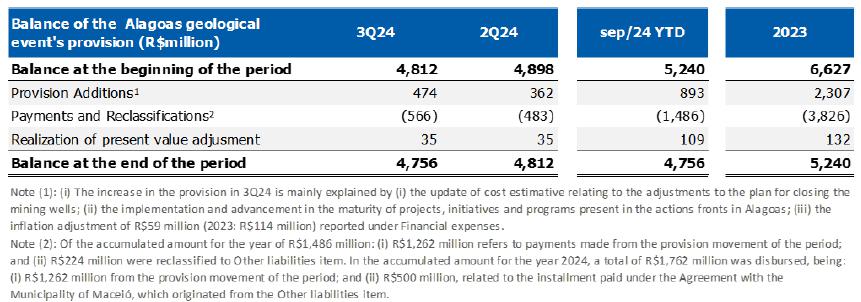
The
total amounts recorded from the beginning of actions related the geological event in Alagoas until the period ending September 30, 2024,
are segregated into the following action fronts:

a. Support
for relocation and compensating: Refers to actions to support for relocating and compensating for the residents, business, and real
state owners of properties located in the Civil Defense Map (version 4) updated in December 2020, including establishments that requires
special measures for their relocation, such as hospitals, schools, and public equipment.
This
action has a provision of R$1.2 billion (2023: R$1.4 billion) that comprises expenses related to relocation actions, such as relocation
allowance, rent allowance, household goods transportation, and negotiation of individual agreements for financial compensation.
By
September 30, 2024, 99.8% of the residents of the properties had already been relocated, and 100% of the criticality area 00, of the
Civil Defense map version 4 of 2020, has already been relocated. 19,167 proposals were submitted (99.9% of the total planned), and the
general acceptance rate of the proposals is 99.6%. In addition, 18,944 proposals for financial compensation were accepted (98.7% of the
total planned), and 18,756 (97.8% of the total planned) were paid. Under the Financial Compensation and Relocation Support Program (PCF),
more than R$ 4.1 billion were disbursed from the beginning of the program to the end of September 2024.
b. Actions
for closing and monitoring the salt cavities, environmental actions and other technical matters: Based on the findings of sonar and
technical studies, stabilization and monitoring actions were defined for all 35 existing salt mining areas. On December 10, 2023, after
atypical microseismic activity, cavity 18 collapsed. Technical information available so far indicates that the direct impacts from this
event are restricted to the location of this cavity, within the protection area, which has been vacant since April 2020. The collapse
of cavity 18 led to the preventive suspension of activities in the protection and surrounding areas, which resumed in February 2024 after
the release of access to the area by the Civil Defense of Maceió.
Moreover,
in January 2024, the Company, following the advice of specialized consulting firms, decided that the most suitable method for closing
the 6 cavities in the Monitoring Group, which were periodically monitored using sonar, was to fill them with solid material (sand). This
decision was based on the findings of the latest geomechanical studies.
In
addition, it was not possible to achieve the pressurization of 3 cavities planned to be closed by buffering. As a result of extensive
analyses, studies, and consultations with experts, the Company decided in September 2024 to fill them with sand, adhering to the experts'
recommendation. The decision was presented to the ANM.
The
closure plan of 35 mining areas currently considers the following:
| i) | 16
cavities are recommended to be filled with sand, including the 3 cavities recently added
to the group, which would previously be closed by buffering. To date, 6 cavities have already
been filled (cavities 04, 07, 11, 17, 19 e 25), 3 cavities are in the filling process (cavity
27 with 66% e cavities 20/21 with 10%, by September 30, 2024), and the remaining 7 cavities
are in the preparation and planning activities; |
| ii) | 6
cavities were naturally filled and, therefore, do not indicate, at this moment, the need
for additional measures, and the cavity 18, currently undergoing technical studies to confirm
its natural filling, indicating that no sand filling measures will be necessary; |
| iii) | 13
cavities must be closed by buffering, a technique that consists of pressurizing the cavity,
and for 9 of them the pressurization was confirmed. In the remaining 4 cavities, actions
are underway to verify pressurization and additional measures may be necessary. Even for
pressurized cavities, stability must continue to be monitored, and the closure plan must
be periodically reviewed and updated, if necessary, to ensure the definitive stabilization
and closure of all mining wells. Any need for additional actions is assessed on an ongoing
basis by the Company, with the support of external consultants, based on the most recent
data available, which may result in relevant additional costs and expenses that may differ
from current estimates and provisions. |
All
of the Company’s actions are based on technical studies prepared by external specialists, whose recommendations may be updated
periodically according to the changes in the geological event, being submitted to competent authorities and following the execution timeframe
agreed under the closure plan, which is public and regularly revaluated with ANM. The most recent revision of the plan was submitted
to the ANM in September 2024. Subsidence is a dynamic process occurring in the area outlined by the priority action lines map and should
continue to be monitored during and after the actions envisaged in the closure plan. The results of the monitoring activities will be
important to assess the need for potential future actions. Any potential future actions may result in significant additional costs and
expenses that may differ from current estimates and provisions.
The
provisioned balance amount of R$1.5 billion (2023: R$1.6 billion) to implement actions for closing and monitoring the salt cavities,
environmental actions, and other technical matters was calculated based on existing techniques and the solutions planned for the current
conditions of the cavities, including expenses with technical studies and monitoring, as well as environmental actions already identified.
The provision amount may be changed based on new information, such as: results of the monitoring of the cavities, progress of implementing
the plans to close mining areas, possible changes to be made to the environmental plan, monitoring of the ongoing measures and other
possible natural alterations. The monitoring system implemented by Braskem envisages actions developed during and after the closure of
mining areas, focusing on safety and monitoring of the region’s stability.
Regarding
environmental actions, in June 2022, in compliance with the Agreement for Socio-environmental Reparation, Braskem submitted to the MPF
the environmental diagnosis containing the assessment of the potential environmental impacts and damages arising from salt mining activities
and the environmental plan with proposals of the measures required. As established in the agreement, the parties jointly defined a second
specialized company that will evaluate and monitor the environmental plan. In December 2022, an additional report on the environmental
plan was filed with the MPF, which validated the plan proposed and provided technical suggestions for execution. In February 2023, this
environmental plan was approved by the MPF, incorporating the suggestions provided in the additional report. Braskem continues implementing
the actions established in the approved environmental plan and sharing the results of its actions with the authorities. Also agreed was
that the environmental diagnosis will be updated in December 2025.
As
one of the results of the collapse of cavity 18, as agreed in the Socio-Environmental Reparation Agreement, a specialized company is
preparing a specific Environmental Diagnosis to evaluate potential impacts caused by the collapse of said cavity. In the initial assessments
performed so far, no alteration in quality of the lake water has been identified.
c. Socio
and urban measures: Refers to actions in compliance with social and urban measures, under the Agreement for Socio-environmental Reparation
signed on December 30, 2020, for the adoption of actions and measures in vacated areas, urban mobility and social compensation actions,
indemnification for social damages and collective pain and suffering and possible contingencies related to the actions in the vacated
areas and urban mobility actions. To date, of the 11 projects defined for urban mobility, 5 have already been completed (Sistema Chã
da Jaqueira, Ladeira Santa Amélia, Rua Marquês de Abrantes, Via Lateral da Av. Menino Marcelo and Binário da Ladeira
do Cálmon), 3 are in progress with the Intelligent Traffic Light System in assisted operation and the first stage of the Side
Roads of Avenida Durval de Goes Monteiro completed. The remaining actions are in planning and execution, awaiting approval of the executive
projects and respective area clearance. The expectation is to complete all urban mobility actions by 2026. Regarding actions in vacated
areas, the overall progress of the Encosta do Mutange Stabilization project is 82.2% as of September 30, 2024, and demolition activities
in this area have been completed. Other actions, such as earthworks, construction of a drainage system, and planting of vegetation cover
in the involved area, are ongoing, with completion expected by the first quarter of 2025. Other activities related to emergency demolitions
in the areas are proceeding as requested by the DCM and have reached 43.4% of the total area to be demolished (56% in number of properties).
Additionally, the Company continues to take actions to care for the neighborhoods, including property security, waste management, and
pest control. Regarding the Social and Urban Action Plan ("PAS"), 48 actions have already been validated with authorities signatories
to the agreement and of these, 3 are being implemented in the cultural sector (Cultural Support Program, Cultural Heritage Inventory,
and Call for Proposals to Support Culture), 03 construction actions are in the land analysis phase, and another 03 are in the conceptual
project development and validation phase. The balance of the provision is R$1.3 billion (2023: R$1.4 billion).
Additional
measures: Refers to actions regarding: (i) actions related to the Technical Cooperation Agreements entered into by the Company; (ii)
expenses with managing the geological event in Alagoas relating to communication, compliance, legal services, etc.; (iii) additional
measures to assist the region and maintenance of areas, including actions for requalification and indemnification directed to Flexais
region; and (iv) other matters classified as a present obligation for the Company, even if not yet formalized. Regarding the Urban Integration
and Development Project of Flexais, significant progress has been made in the process of compensating residents (Financial Support Program
- PAF), with 1,804 proposals submitted (99.5% of the total) and 1,793 payments completed (99.4% of the proposals) by September 30, 2024.
The project’s goal is to promote access to essential public services and encourage the local economy of Flexais, aiming to address
the socio-economic isolation of the region. Of the 23 actions established in the project, 14 have been implemented (12 are ongoing and
2 have been fully completed), 4 are in execution, and 5 are planned to start in the coming months. The balance
of additional measures described in this item totals R$834 million (2023: R$935 million).
The
provisions of the Company are based on current estimates and assumptions and may be updated in the future due to new facts and circumstances,
including, but not limited to: changes in the execution time, scope and method and the success of action plans; new repercussions or
developments arising from the geological event, including possible revision of the Civil Defense Map; studies that indicate recommendations
from specialists, including the Technical Monitoring Committee, according to Agreement for Compensation of Residents, detailed in item
23.1 (i) of the consolidated and individual Financial Statements as of September 30, 2024, and other new developments in the matter.
The
measures related to the plans to close mining areas are also subject to the analysis and approval by the ANM, the monitoring of results
of the measures under implementation as well as changes related to the dynamic nature of the geological event.
Continuous
monitoring is essential for confirming the results of the current recommendations. Accordingly, the plan to close mining areas may be
updated based on the need to adopt technical alternatives to stabilize and permanently close all pressurized cavities, including but
not limited to all other points mentioned above. In addition, the assessment of the behavior of cavities could indicate the need for
certain additional measures to stabilize them.
The
actions to repair, mitigate or offset potential environmental impacts and damages, as provided for in the Socio-environmental Reparation
Agreement, were defined considering the environmental diagnosis prepared by a specialized and independent company. After the conclusion
of all discussions with authorities and regulatory agencies, as per the process established in the agreement, an action plan was agreed
to be part of the measures for a Plan to Recover Degraded Areas (“PRAD”).
On
May 21, 2024, the final report of the Parliamentary Investigative Committee ("CPI"), set up by the Senate on December 13, 2023,
was approved, with the purpose of investigating the effects of the Company's socio-environmental legal liability related to the geological
event in Alagoas. On this date, the aforementioned CPI was declared closed, with the subsequent submission of the final report to the
appropriate institutions.
There
are also administrative proceedings related to the geological event in Alagoas in progress before the Federal Accounting Court ("TCU")
and the Securities and Exchange Commission of Brazil ("CVM").
In
October 2024, the Company became aware of the conclusion of the Federal Police of Alagoas investigation that had been ongoing since 2019.
The investigation files remain confidential and must be forwarded to the Public Prosecutor's Office for evaluation, ending the police
investigation phase. The Company reiterates that it has always been at the disposal of authorities and has been providing all information
related to salt mining exploration over the course of the investigation.
The
Company has been making progress in negotiations with public entities about other indemnification requests to understand them better.
Although future disbursements may occur as a result of said negotiations, as of the reporting date, the Company is unable to predict
the results and timeframe for concluding these negotiations or its possible scope and the total associated costs in addition to those
already provisioned for.
It
is not possible to anticipate all new claims, related to damages or other nature, that may be brought by individuals or groups, including
public or private entities, that understand they suffered impacts or damages somehow related to the geological phenomenon and the relocation
of people from risk areas, as well as new notices of violation or administrative penalties of diverse natures. Braskem continues to face
and could still face administrative procedures and various lawsuits filed by individuals or legal entities not included in the PCF or
that disagree with the financial compensation offer for individual settlement, as well as new collective actions and new lawsuits filed
by public utility concessionaires, entities of the direct or indirect administration of the State, Municipalities or Federal level. Therefore,
the number of such actions, their nature or the amounts involved cannot be estimated at this moment.
Consequently,
the Company cannot eliminate the possibility of future developments related to all aspects of the geological event in Alagoas, the relocation
process and actions in vacated and adjacent areas, so the expenses to be incurred may significantly differ from its estimates and provisions.
In
February 2023, the Company signed a settlement agreement with the insurance companies, closing the claim for the geological event in
Alagoas.
For
more information, please check explanatory note 23 ("Geological event – Alagoas") of the consolidated and individual
Financial Statements as of September 30, 2024.
| 8.4 | CONSOLIDATED
INCOME STATEMENT |
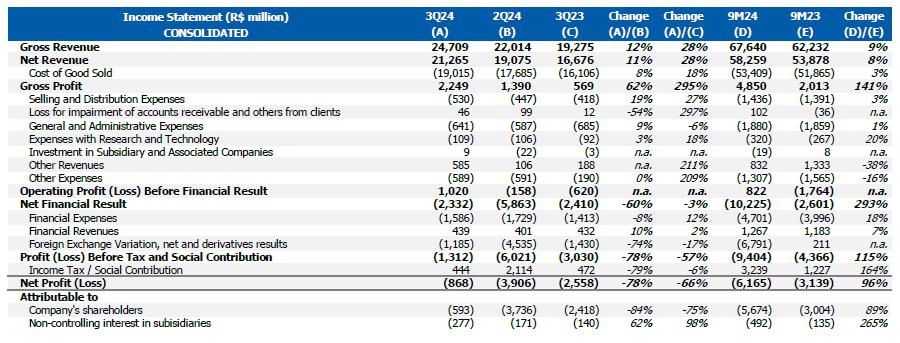
| 8.5 | CONSOLIDATED
RECURRING EBITDA CALCULATION |

| 8.6 | RECURRING
EBITDA BY SEGMENT |
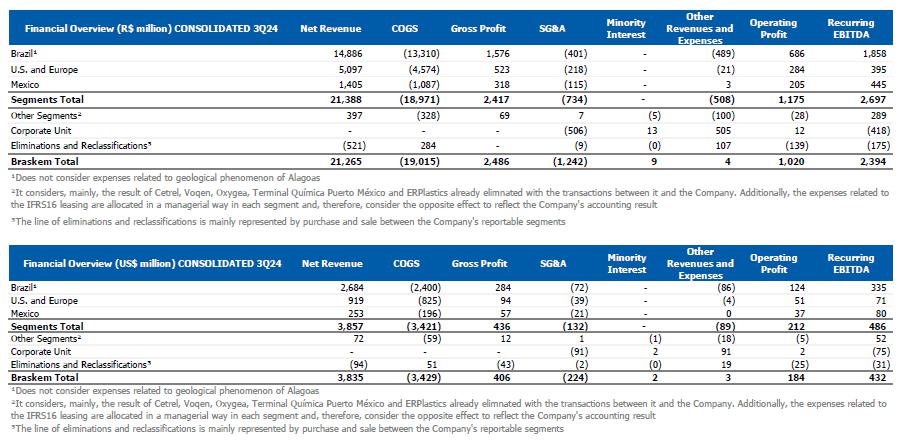
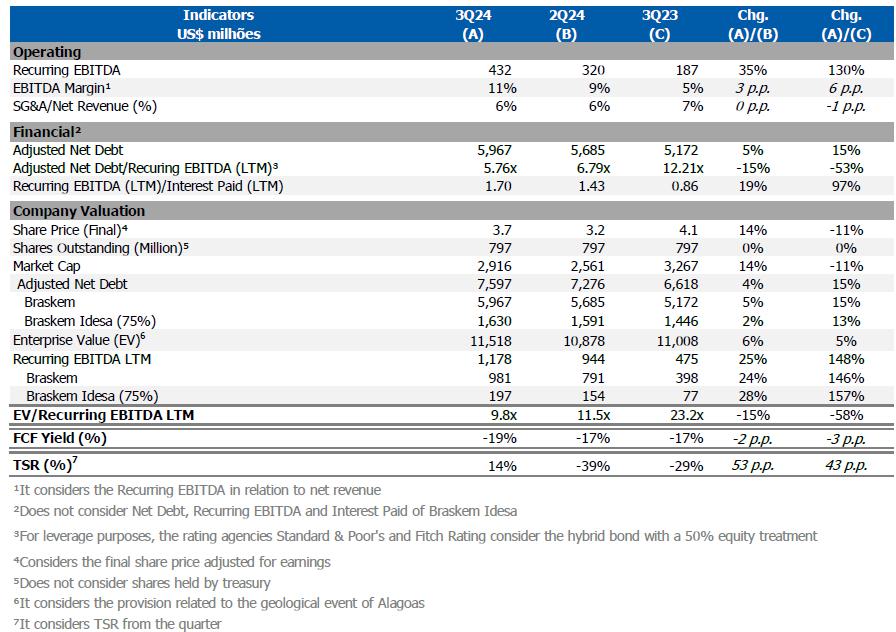
| 8.8 | CONSOLIDATED
BALANCE SHEET |
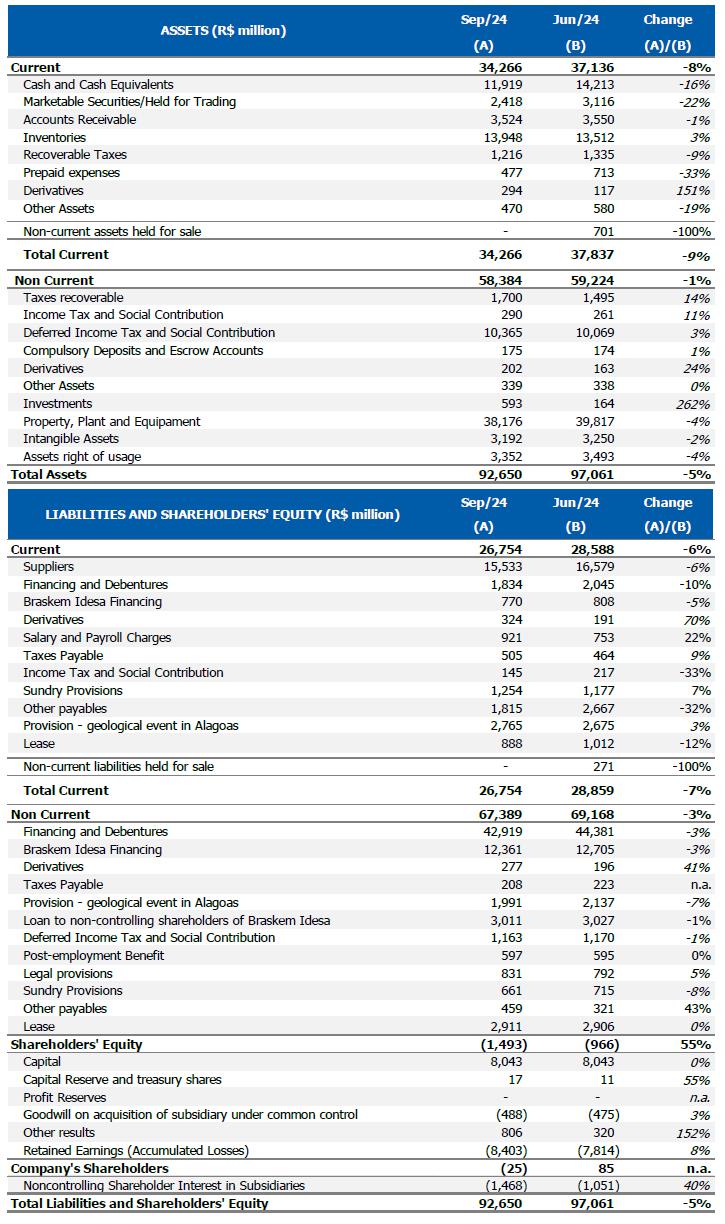
| 8.9 | CONSOLIDATED
CASH FLOW |
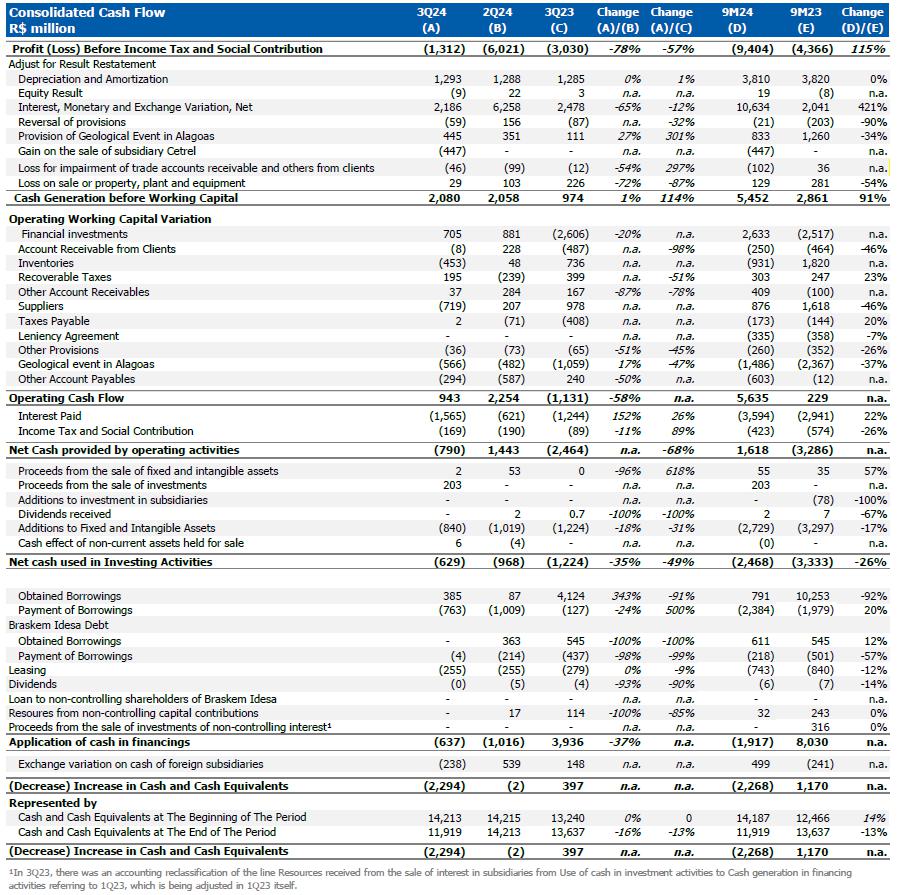
| 8.10 | BRASKEM
IDESA INCOME STATEMENT |

| 8.11 | BRASKEM
IDESA BALANCE SHEET |
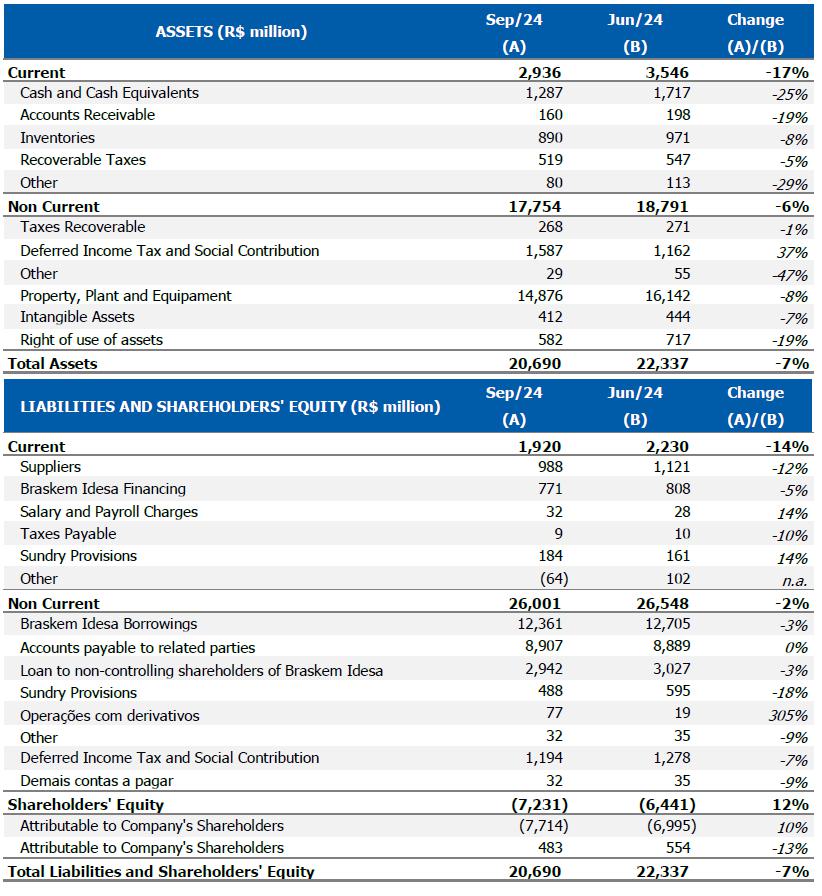
| 8.12 | BRASKEM
IDESA CASH FLOW |
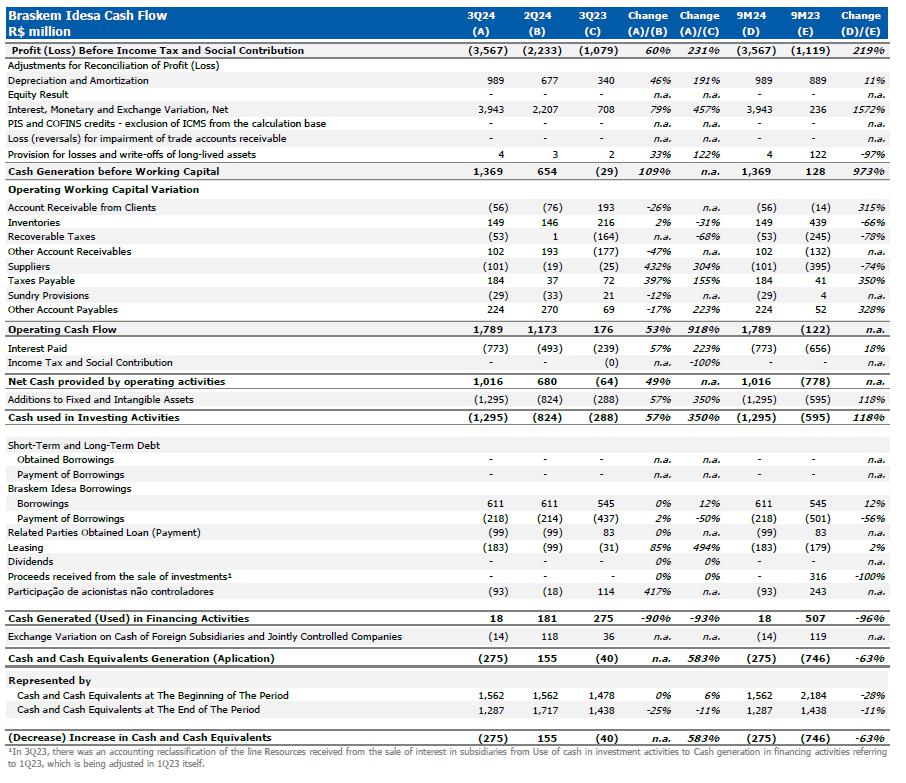
SIGNATURES
Pursuant
to the requirements of the Securities Exchange Act of 1934, the registrant has duly caused this report to be signed on its behalf
by the undersigned, thereunto duly authorized.
Date: November 7, 2024
| |
BRASKEM S.A. |
| |
|
|
|
| |
|
|
|
| |
By: |
/s/ Pedro van Langendonck Teixeira de Freitas |
| |
|
|
| |
|
Name: |
Pedro van Langendonck Teixeira de Freitas |
| |
|
Title: |
Chief Financial Officer |
DISCLAIMER ON FORWARD-LOOKING STATEMENTS
This
report on Form 6-K may contain forward-looking statements within the meaning of the Private Securities Litigation Reform Act of
1995. These statements are statements that are not historical facts, and are based on our management’s current view and estimates
of future economic and other circumstances, industry conditions, company performance and financial results, including any potential
or projected impact of the geological event in Alagoas and related legal proceedings and of COVID-19 on our business, financial
condition and operating results. The words “anticipates,” “believes,” “estimates,” “expects,”
“plans” and similar expressions, as they relate to the company, are intended to identify forward-looking statements.
Statements regarding the potential outcome of legal and administrative proceedings, the implementation of principal operating and
financing strategies and capital expenditure plans, the direction of future operations and the factors or trends affecting our
financial condition, liquidity or results of operations are examples of forward-looking statements. Such statements reflect the
current views of our management and are subject to a number of risks and uncertainties, many of which are outside of the our control.
There is no guarantee that the expected events, trends or results will actually occur. The statements are based on many assumptions
and factors, including general economic and market conditions, industry conditions, and operating factors. Any changes in such
assumptions or factors, including the projected impact of the geological event in Alagoas and related legal proceedings and the
unprecedented impact of COVID-19 pandemic on our business, employees, service providers, stockholders, investors and other stakeholders,
could cause actual results to differ materially from current expectations. Please refer to our annual report on Form 20-F for the
year ended December 31, 2019 filed with the SEC, as well as any subsequent filings made by us pursuant to the Exchange Act, each
of which is available on the SEC’s website (www.sec.gov), for a full discussion of the risks and other factors that may impact
any forward-looking statements in this presentation.
Braskem (NYSE:BAK)
Historical Stock Chart
From Oct 2024 to Nov 2024
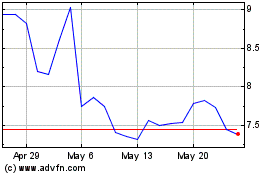
Braskem (NYSE:BAK)
Historical Stock Chart
From Nov 2023 to Nov 2024
